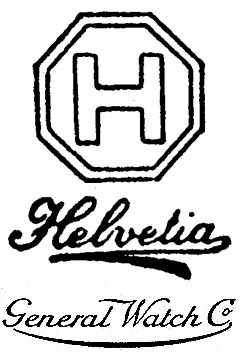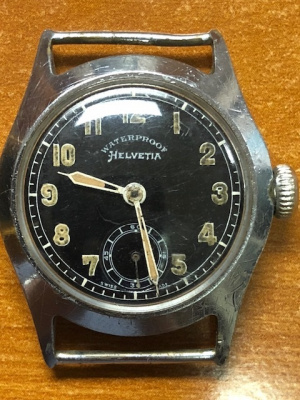Helvetia: Difference between revisions
| (12 intermediate revisions by the same user not shown) | |||
| Line 1: | Line 1: | ||
==Helvetia== | ==Helvetia== | ||
[[File:Helvetia.jpg|thumb]] | |||
===Early days=== | |||
The history of the Helvetia watch goes way back to 1848, to Louis Brands . By 1880 Louis and his brother set up a watch manufacturing business, La Generale Watch Co (General Watch Company). Helvetia is the female personification of the Swiss nations. The watches produced by the Brands brothers were highly prized and by incorporation of the new lever movements in 1885, they produced timepieces that were accurate to within 30 seconds per day. Four years later the General Watch company became the largest producer of watches in Switzerland. They formed collaborations with other manufacturers, most notably [[Audemars Piguet]] and produced highly desirable watches. | |||
[[Omega]] had a financial position in Gw Co/Helvetia at the start of the 20th century, However Omega gave up its stake in 1911 and they became independent. From the late 1920s it seems as if the GW Co adopted ‘Montres Helvetia’ or ‘The Helvetia Watch Company’ as its main trading name and began to manufacture movements and watches marked Helvetia at its movement factory ‘Helvetia SA' in Reconvilier and its watch factory ‘Montres Helvetia SA’ in Bienne. | |||
In the mid 1920s Helvetia/General Watch Co started producing watches with a cross-shaped spring on the balance of the movement which looked like a simplified version of the Depollier/Brun system. During this period one of the main importers of Helvetia watches into the UK was the company ‘Robert Pringle and Sons’ of London. | |||
Helvetia were at the forefront of watchmaking technology and filed patents for a shock protection system for movement balances in 1929, a waterproof crystal fitting in 1931 and an anti-shock movement mounting in 1933 as well as developing centre sweep seconds movements, calendar watches and ‘Stop Second’ chronographs in the mid to late 1930s. Helvetia sold their water and shock-protected watches to a variety of retailers and they often added their own branding. Examples would include: G & M Lane, Huber, and Abercrombie & Fitch. | |||
===WW2 and after=== | |||
During WWII Helvetia manufactured wristwatches for the German armed forces, these watches are marked with a D and H or DI and H on the case back. They also provided pocket watches for the allies. After the war, watch production in Switzerland rose steadily and in this period Helvetia produced some of their best watches. Larger than average for the time and often with centre sweep seconds. They also produced a lot of military style watches at this time to cater for the large market made up of ex-servicemen returning home from the war. | |||
Throughout the 1950s and 60s production carried on rising rapidly and Helvetia continued to develop their in-house movements for their watches, though they abandoned their own patent shock protection system in the early 1950s for the ubiquitous Incabloc system. They also updated their logo in about 1965 to a more 'modern' looking one. | |||
===SGT and the end=== | |||
In 1968 Helvetia became one of the founding members of the Swiss watch group Societe des Garde-Temps SA (SGT) along with 8 other watch companies including, [[Avia]], [[Sandoz]] and [[Silvana]]. With this move Helvetia severed its link with the General Watch Company and it appears the General Watch Company joined [[AUSAG]] soon afterwards and was used as a holding company for the movement manufacturers AUSAG absorbed. | |||
[[SGT]] was the third largest group of watch making companies in Switzerland, after [[AUSAG]] and [[SSIH]], and continued making watches through the 1970s including the first LCD display digital watch in 1972. Helvetia started adding model names to its watches at this time such as ‘Waterstar’ and ‘Beatmaster’ but by the end of the 1970s the whole Swiss watch industry was suffering, under pressure from the rise of cheaper Japanese competition and sales dropped heavily. In 1981 SGT could no longer withstand the Japanese onslaught and the rights to its individual brands were sold off and it dissolved. | |||
| |||
==Links== | ==Links== | ||
[[File:Helvetia ww2.jpg|thumb]] | |||
* [[Switzerland]] | * [[Switzerland]] | ||
* [[Main Page]] | * [[Main Page]] | ||
*[[Military Watches]] | |||
==Credits and External Links== | |||
Thanks to https://www.helvetiahistory.co.uk | |||
Latest revision as of 17:29, 29 April 2020
Helvetia

Early days
The history of the Helvetia watch goes way back to 1848, to Louis Brands . By 1880 Louis and his brother set up a watch manufacturing business, La Generale Watch Co (General Watch Company). Helvetia is the female personification of the Swiss nations. The watches produced by the Brands brothers were highly prized and by incorporation of the new lever movements in 1885, they produced timepieces that were accurate to within 30 seconds per day. Four years later the General Watch company became the largest producer of watches in Switzerland. They formed collaborations with other manufacturers, most notably Audemars Piguet and produced highly desirable watches.
Omega had a financial position in Gw Co/Helvetia at the start of the 20th century, However Omega gave up its stake in 1911 and they became independent. From the late 1920s it seems as if the GW Co adopted ‘Montres Helvetia’ or ‘The Helvetia Watch Company’ as its main trading name and began to manufacture movements and watches marked Helvetia at its movement factory ‘Helvetia SA' in Reconvilier and its watch factory ‘Montres Helvetia SA’ in Bienne.
In the mid 1920s Helvetia/General Watch Co started producing watches with a cross-shaped spring on the balance of the movement which looked like a simplified version of the Depollier/Brun system. During this period one of the main importers of Helvetia watches into the UK was the company ‘Robert Pringle and Sons’ of London.
Helvetia were at the forefront of watchmaking technology and filed patents for a shock protection system for movement balances in 1929, a waterproof crystal fitting in 1931 and an anti-shock movement mounting in 1933 as well as developing centre sweep seconds movements, calendar watches and ‘Stop Second’ chronographs in the mid to late 1930s. Helvetia sold their water and shock-protected watches to a variety of retailers and they often added their own branding. Examples would include: G & M Lane, Huber, and Abercrombie & Fitch.
WW2 and after
During WWII Helvetia manufactured wristwatches for the German armed forces, these watches are marked with a D and H or DI and H on the case back. They also provided pocket watches for the allies. After the war, watch production in Switzerland rose steadily and in this period Helvetia produced some of their best watches. Larger than average for the time and often with centre sweep seconds. They also produced a lot of military style watches at this time to cater for the large market made up of ex-servicemen returning home from the war.
Throughout the 1950s and 60s production carried on rising rapidly and Helvetia continued to develop their in-house movements for their watches, though they abandoned their own patent shock protection system in the early 1950s for the ubiquitous Incabloc system. They also updated their logo in about 1965 to a more 'modern' looking one.
SGT and the end
In 1968 Helvetia became one of the founding members of the Swiss watch group Societe des Garde-Temps SA (SGT) along with 8 other watch companies including, Avia, Sandoz and Silvana. With this move Helvetia severed its link with the General Watch Company and it appears the General Watch Company joined AUSAG soon afterwards and was used as a holding company for the movement manufacturers AUSAG absorbed.
SGT was the third largest group of watch making companies in Switzerland, after AUSAG and SSIH, and continued making watches through the 1970s including the first LCD display digital watch in 1972. Helvetia started adding model names to its watches at this time such as ‘Waterstar’ and ‘Beatmaster’ but by the end of the 1970s the whole Swiss watch industry was suffering, under pressure from the rise of cheaper Japanese competition and sales dropped heavily. In 1981 SGT could no longer withstand the Japanese onslaught and the rights to its individual brands were sold off and it dissolved.
Links

Credits and External Links
Thanks to https://www.helvetiahistory.co.uk
